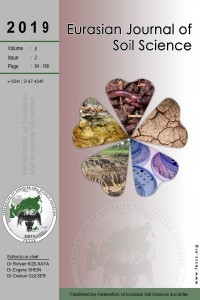
Eurasian Journal of Soil Science
Yazarlar: Sani İssa MAHAMAN SANOUSSİ, Fatondji DOUGBEDJİ, Ezenwa MATTHEW, A.a. OKHİMAMHE, Ali IBRAHİM, İsiah SULE
Konular:Fen
DOI:10.18393/ejss.642212
Anahtar Kelimeler:Fertilizer micro-dosing,Sustainability,Nutrient mining,Long-term,Sahel
Özet: In the Sahel, mineral fertilizer micro-dosing technique is known for its benefits to provide higher nutrient uptake and higher crop yields. A study was set up at ICRISAT research station at Sadoré in Niger, which aims at evaluating the sustainability of the technology in the long-term with emphasis on soil nutrients dynamics. The study has started since 2008 and was laid-out in a randomized complete block design that involved two pearl millet varieties, three planting densities, and four nutrients management options. For this study, a sub-set of the treatments from this long-term experiment was used. The nutrient management factor, which includes 4 levels was considered. The most important findings obtained indicated that the change in soil nutrient was markedly different on the planting hills and that from between hill. The change in soil pH-H2O values on the planting was -7.06 % for the control plots and -9.57 % for the plots applied with NPK. The total nitrogen content has dropped in the two different plots. The amplitude of drop has lowered with the application of NPK micro-dosing on the planting hills with respectively -5.11 % and -12.45 % in the control plots and the micro-dose plots. Positive change in available P was significantly observed (P≤0.05) in soil between hill with 1.08% in the control plots and 15.97 % in the amended plots. Both grain yield and total dry matter showed similar trend in which decreased yield was obvious over the time. In 2008, an average grain yield of 732 kg. ha-1 and 989 kg. ha-1 was obtained respectively for the control plots and 6g per hill of NPK plots. Whereas in 2016, 146 kg. ha-1 and 218 kg. ha-1 were produced respectively for the control plots and the mineral fertilizer micro-dosing plots. These findings indicated that in the Sahel low-input based millet cropping systems, for the mineral fertilizer micro-dosing technology to be sustainable in the long term, the improvement and maintenance of soil fertility should be considered as the cornerstone.